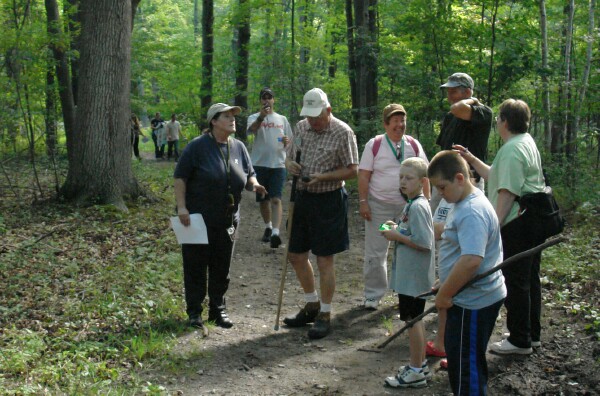
Geocachers Gather at Saginaw Basin Land Conservancy Sand Point Reserve
September 12, 2009
By: Stephen Kent
The
Saginaw Basin Land Conservancy (SBLC) held it's first Geocaching event at the new Sand Point Nature Preserve on Saturday, September 12. The event was attended by about 25 people. Some were experienced Geocachers, some were new to the sport and some, like your reporter had no idea what to expect.
The 139 acre Sand Point Preserve is one of the newest additions to the SBLC properties. The preserve runs from M-25 to the Bay. The formerly private land has several dirt roads which are not open to vehicles but make great walking paths through a beautiful forest with abundant wildlife.
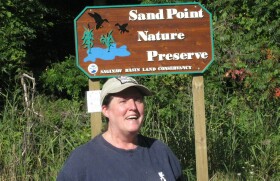
Organizer Darlene Elias aka "Windrose"
Saturday's event was organized by AmeriCorp member Neil Sauter who has been working with the SBLC. The Geocache course was set up by Darlene Elias, known to Geocachers as "Windrose". "Geocaching started in 2000 when the government open the GPS satellite system to the public" said Elias, who has been geocaching for seven years. "One man had the idea to hide something then challenge his friend to find it with only the GPS coordinates. It proved to be great fun and the sport was born." Using the Internet, the sport quickly spread nationwide.

Saturday's event was announced on the Michigan Geocaching Organization (MiGO) web site. MiGO, founded in 2002, is one of the oldest such organizations in the country. It promotes the sport of Geocaching in Michigan and provides information to the public about the sport of geocaching. The organization's web site,
Mi-Geocaching.org provides a wealth of information.
The concept of geocaching is a modern update of hide and go seek. Someone hides a cache of objects then provided the GPS coordinate to the location and some clues. Other people use their GPS device to locate the general area then use the clues to find the cache.
You don't need an expensive GPS device to participate. Some purists use maps and compasses. Others use Internet maps or Google Earth to find the area then go into the field with little more than their research findings. Those who use GPS devices may have very simple and inexpensive units while others use high end units with many features.
A cache is typically a simple container. The most popular are plastic containers, jars and cans. The clues give you an idea what to look for and the level of difficulty. The more devious caches are called nanoscale or "nanos" and can be the size of a thimble.
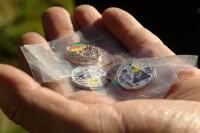
Path Tags
The cache itself typically contains a log which people sign and replace. Some caches contain small tokens the finder can take with them. Some people leave their own token or item for others to find.
Saturday's event was a search for temporary caches that were hidden specifically for the day. Many locations have permanent caches that are registered with one of the Internet services like
GeoCaching.com
where finders can log their name and thus keep score. The site catalogs almost 900,000 geocaches. Visit the site to find a cache near you!
The path tags can be purchased and logged at
pathtags.com.
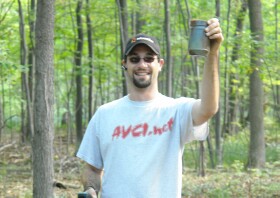
Brock "KC8KOD" - first find of day.
Elias tells the story of a permanent cache she placed only to have people report that they simply could not find. She went to check and it was in fact gone. She made up a new cache but when she returned the original was back in place. "Some man found it and didn't know what it was. He took it home and later opened. Realizing what was, he added his own name to the log and put it back where he found it."
Geocaching is not an exact science. GPS devices can locate a point to within about 20 feet. The satellite signals are affected by atmospheric conditions, terrain, and obstructions, even trees. According to SaginawMike, a 2 year geocacher, "You get close then use the clues and your experience to find the cache. That's the fun and it's where your skill comes in."
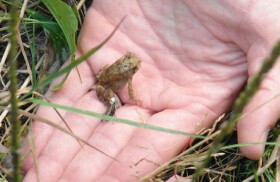
Cute frog, but not on the cache list

Cameron: Ready to hit the trail
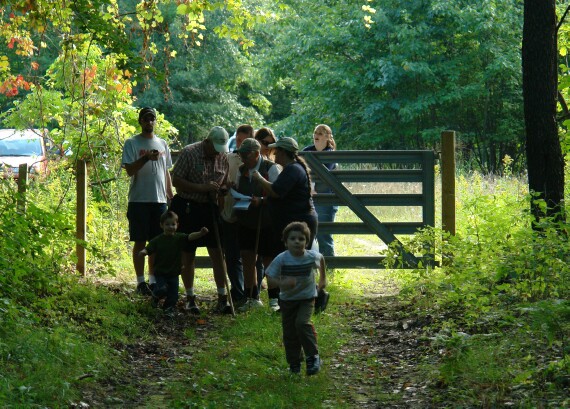
Someone seems to know where he's going already!
Sand Point Nature Preserve Location
View Larger Map
The Saginaw Basin Land Conservancy helps maintain the quality of life in the Saginaw Bay Watershed through the preservation of important wetlands, waterways and land of all types. The Conservancy is a non-profit charitable organization working in the Saginaw Basin. To date, the Conservancy has permanently preserved more than 5,000 acres in the watershed.

